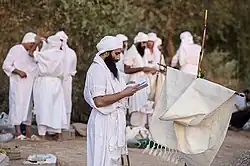Masbuta
Maṣbuta (Classical Mandaic: ࡌࡀࡑࡁࡅࡕࡀ) is the ritual of immersion in water in the Mandaean religion.[1][2]
| Part of a series on |
| Mandaeism |
|---|
 |
| Religion portal |

Overview
Mandaeans revere John the Baptist and practice frequent baptism (masbuta) as ritual purification, not of initiation. They are possibly one of the earliest peoples to practice ritual baptism.[3] Mandaeans undergo baptism on Sundays (Habshaba[4]), wearing a white sacral robe (rasta). Baptism for Mandaeans consists of a triple full immersion in water, a triple signing of the forehead with water and a triple drinking of water. The priest (rabbi) then removes a ring made of myrtle (klila) worn by the baptized and places it on their forehead. This is then followed by a handshake (kušṭa - hand of truth) with the priest. The final blessing involves the priest laying his right hand on the baptized person's head.[5]: 102
Living water (fresh, natural, flowing water, called mia hayyi)[5] is a requirement for baptism, therefore can only take place in rivers. All rivers are named Yardna "Jordan River" and are believed to be nourished by the World of Light. By the riverbank, a Mandaean's forehead is anointed with sesame oil (misha) and partakes in a communion of sacramental bread (pihta) and water. Baptism for Mandaeans allows for salvation by connecting with the World of Light and for forgiveness of sins.[6][7][8]
Although masbuta rituals are typically held only in the presence of Mandaeans, a historic commemorative masbuta ceremony was held at the 13th conference of the ARAM Society (titled "The Mandaeans"), which took place during 13-15 June 1999 on the banks of the Charles River at Harvard University.[9][10]
Types
There are different types of masbuta used for different purposes. Similarly, there are also several different types of masiqta (see Masiqta § Types). A few types of masbuta are:
- 360 baptisms: 360 consecutive baptisms are needed to cleanse a polluted priest.[1] Sets of 360 baptisms are described in texts such as The Baptism of Hibil Ziwa and Šarḥ ḏ-Maṣbuta Rabia ("The Scroll of the Great Baptism"; DC 50).
- Masbuta of Zihrun Raza Kasia, described in the Zihrun Raza Kasia scroll.[11]
Masbuta is distinct from ṭamaša "immersion" and rišama "ablution", which are personal ritual purification rituals that do not require the presence of a priest. Ṭamaša is typically performed after bodily pollutions, such as seminal discharge, sexual activity, or after subsiding from unclean thoughts or anger at another person. This ablution is comparable to tevilah in Judaism and ghusl in Islam. Rišama is performed daily before prayers and religious ceremonies or after bowel evacuation and is comparable to wudu in Islam.[12]
Parallels
Birger A. Pearson finds many parallels between the Sethian ritual of the Five Seals and the Mandaean baptismal ritual of masbuta.[13]
See also
Further reading
- Buckley, Jorunn Jacobsen (1989). "Why Once Is Not Enough: Mandaean Baptism (Maṣbuta) as an Example of a Repeated Ritual". History of Religions. University of Chicago Press. 29 (1): 23–34. doi:10.1086/463169. ISSN 0018-2710. JSTOR 1062837. S2CID 161224842.
- Buckley, Jorunn Jacobsen (2007). "Polemics and Exorcism in Mandaean Baptism". History of Religions. University of Chicago Press. 47 (2/3): 156–170. doi:10.1086/524208. ISSN 0018-2710. S2CID 162202078.
- Nasoraia, Brikha (2022). Masbuta: The Mandaean Baptism (forthcoming). Belgium: Brepols Publishers.
References
- Buckley, Jorunn Jacobsen (2002). The Mandaeans: ancient texts and modern people. New York: Oxford University Press. ISBN 0-19-515385-5. OCLC 65198443.
- Segelberg, Eric (1958). Maṣbuta: Studies in the Ritual of Mandaean Baptism. Uppsala: Almqvist and Wiksell.
- McGrath, James (23 January 2015), "The First Baptists, The Last Gnostics: The Mandaeans", YouTube-A lunchtime talk about the Mandaeans by Dr. James F. McGrath at Butler University, retrieved 3 November 2021
- "The Comprehensive Aramaic Lexicon". cal.huc.edu.
- Drower, Ethel Stefana (1937). The Mandaeans of Iraq and Iran. Oxford at the Clarendon Press.
- "Mandeans", US News, archived from the original on 21 October 2013
- Yamauchi, Edwin M (2004), Gnostic Ethics and Mandaean Origins, Gorgias Press, p. 20, ISBN 978-1-931956-85-7
- History, Mandean union, archived from the original on 17 March 2013
- Coakley, J.F. (1999). "The Thirteenth Conference of the ARAM Society: The Mandaeans". ARAM, 11-12 (1999-2000), 199-208.
- ARAM, "[https://mandaeanpriests.exeter.ac.uk/items/show/44 Masbuta (full Baptism) Harvard 1999," The Worlds of Mandaean Priests.
- Burtea, Bogdan (2008). Zihrun, das verborgene Geheimnis (in German). Wiesbaden: Harrassowitz. ISBN 978-3-447-05644-1. OCLC 221130512.
- Gelbert, Carlos (2005). The Mandaeans and the Jews. Edensor Park, NSW: Living Water Books. ISBN 0-9580346-2-1. OCLC 68208613.
- Pearson, Birger A. (14 July 2011). "Baptism in Sethian Gnostic Texts". Ablution, Initiation, and Baptism. De Gruyter. pp. 119–144. doi:10.1515/9783110247534.119. ISBN 978-3-11-024751-0.
External links
- Videos and images from the Worlds of Mandaean Priests (University of Exeter)
- Mandaean masbuta performed at 13 June 1999 ARAM conference




